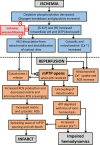Identity, structure, and function of the mitochondrial permeability transition pore: controversies, consensus, recent advances, and future directions
- PMID: 37460667
- PMCID: PMC10406888
- DOI: 10.1038/s41418-023-01187-0
Identity, structure, and function of the mitochondrial permeability transition pore: controversies, consensus, recent advances, and future directions
Abstract
The mitochondrial permeability transition (mPT) describes a Ca2+-dependent and cyclophilin D (CypD)-facilitated increase of inner mitochondrial membrane permeability that allows diffusion of molecules up to 1.5 kDa in size. It is mediated by a non-selective channel, the mitochondrial permeability transition pore (mPTP). Sustained mPTP opening causes mitochondrial swelling, which ruptures the outer mitochondrial membrane leading to subsequent apoptotic and necrotic cell death, and is implicated in a range of pathologies. However, transient mPTP opening at various sub-conductance states may contribute several physiological roles such as alterations in mitochondrial bioenergetics and rapid Ca2+ efflux. Since its discovery decades ago, intensive efforts have been made to identify the exact pore-forming structure of the mPT. Both the adenine nucleotide translocase (ANT) and, more recently, the mitochondrial F1FO (F)-ATP synthase dimers, monomers or c-subunit ring alone have been implicated. Here we share the insights of several key investigators with different perspectives who have pioneered mPT research. We critically assess proposed models for the molecular identity of the mPTP and the mechanisms underlying its opposing roles in the life and death of cells. We provide in-depth insights into current controversies, seeking to achieve a degree of consensus that will stimulate future innovative research into the nature and role of the mPTP.
© 2023. The Author(s).
Conflict of interest statement
The authors declare no competing interests.
Figures




Similar articles
-
Refractive Index Imaging Reveals That Elimination of the ATP Synthase C Subunit Does Not Prevent the Adenine Nucleotide Translocase-Dependent Mitochondrial Permeability Transition.Cells. 2023 Jul 27;12(15):1950. doi: 10.3390/cells12151950. Cells. 2023. PMID: 37566029 Free PMC article.
-
Role of the c subunit of the FO ATP synthase in mitochondrial permeability transition.Cell Cycle. 2013 Feb 15;12(4):674-83. doi: 10.4161/cc.23599. Epub 2013 Jan 23. Cell Cycle. 2013. PMID: 23343770 Free PMC article.
-
The still uncertain identity of the channel-forming unit(s) of the mitochondrial permeability transition pore.Cell Calcium. 2018 Jul;73:121-130. doi: 10.1016/j.ceca.2018.05.003. Epub 2018 May 16. Cell Calcium. 2018. PMID: 29793100 Free PMC article. Review.
-
Mitochondrial Permeability Transition in Stem Cells, Development, and Disease.Adv Exp Med Biol. 2023;1409:1-22. doi: 10.1007/5584_2022_720. Adv Exp Med Biol. 2023. PMID: 35739412 Review.
-
The adenine nucleotide translocase family underlies cardiac ischemia-reperfusion injury through the mitochondrial permeability pore independently of cyclophilin D.Sci Adv. 2024 Dec 13;10(50):eadp7444. doi: 10.1126/sciadv.adp7444. Epub 2024 Dec 11. Sci Adv. 2024. PMID: 39661674 Free PMC article.
Cited by
-
Influence of acidic metabolic environment on differentiation of stem cell-derived cardiomyocytes.Front Cardiovasc Med. 2024 Mar 20;11:1288710. doi: 10.3389/fcvm.2024.1288710. eCollection 2024. Front Cardiovasc Med. 2024. PMID: 38572303 Free PMC article. Review.
-
CKB Promotes Mitochondrial ATP Production by Suppressing Permeability Transition Pore.Adv Sci (Weinh). 2024 Aug;11(31):e2403093. doi: 10.1002/advs.202403093. Epub 2024 Jun 19. Adv Sci (Weinh). 2024. PMID: 38896801 Free PMC article.
-
Multicore, SDS-Based Polyelectrolyte Nanocapsules as Novel Nanocarriers for Paclitaxel to Reduce Cardiotoxicity by Protecting the Mitochondria.Int J Mol Sci. 2025 Jan 22;26(3):901. doi: 10.3390/ijms26030901. Int J Mol Sci. 2025. PMID: 39940670 Free PMC article.
-
Early-Stage Alcoholic Cardiomyopathy Highlighted by Metabolic Remodeling, Oxidative Stress, and Cardiac Myosin Dysfunction in Male Rats.Int J Mol Sci. 2025 Jul 15;26(14):6766. doi: 10.3390/ijms26146766. Int J Mol Sci. 2025. PMID: 40725013 Free PMC article.
-
Advanced Nanomaterial Platforms for Targeted Therapy of Myocardial Ischemia-Reperfusion Injury.Research (Wash D C). 2025 Aug 5;8:0822. doi: 10.34133/research.0822. eCollection 2025. Research (Wash D C). 2025. PMID: 40765995 Free PMC article. Review.
References
-
- Raaflaub J. Swelling of isolated mitochondria of the liver and their susceptibility to physicochemical influences. Helv Physiol Pharmacol Acta. 1953;11:142–56. - PubMed
Publication types
MeSH terms
Substances
Grants and funding
- R01 HL137266/HL/NHLBI NIH HHS/United States
- R01 HL150031/HL/NHLBI NIH HHS/United States
- R56 AG078384/AG/NIA NIH HHS/United States
- R56 AG068999/AG/NIA NIH HHS/United States
- R01 AG058256/AG/NIA NIH HHS/United States
- P30 DK135043/DK/NIDDK NIH HHS/United States
- R37 NS045876/NS/NINDS NIH HHS/United States
- R01 AG069677/AG/NIA NIH HHS/United States
- K01 AG054734/AG/NIA NIH HHS/United States
- P30 DK040561/DK/NIDDK NIH HHS/United States
- RF1 AG072484/AG/NIA NIH HHS/United States
- R01 AG072484/AG/NIA NIH HHS/United States
- R35 GM139615/GM/NIGMS NIH HHS/United States
LinkOut - more resources
Full Text Sources
Miscellaneous

